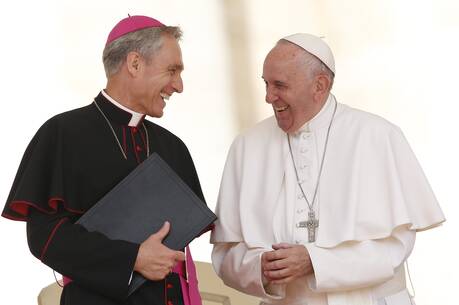A few weeks ago Christians celebrated that Jesus rose into new, resurrected life from a tomb that could not contain the power of divine love. In the northern hemisphere, this high point of the church year coincides with the beginning of spring. As both a farmer and a lay minister, I wonder if there may be a more vital connection between liturgy and nature beyond the mere repetition of their parallel cycles.
The shift from Lenten austerity to Easter exuberance, and the liturgies that mark the transition, invite profound joy and wonder at the mystery of resurrection. Likewise, it is hard not to marvel at how, even on our abused planet, the warmer, longer days of spring bring a flush of new growth after months of winter’s cold, dark dormancy. These reliable rhythms of worship and the natural world sanctify time in a way that the homogenized popular culture, with its nonstop news, entertainment and consumerism, never can.
Yet the resurrection season also has a shadow side. For busy priests and lay ministers, Easter may be a time of joy, but it is also one of exhaustion. I serve as the part-time music director for our small rural parish, and after the marathon liturgies of Holy Week, with first Communion and Pentecost close behind, I sometimes find myself wishing that the church might consider celebrating this holiest of seasons once every decade instead of every year. Christ may have risen, but in the thick of their ministerial responsibilities, many parish ministers may feel on the verge of collapse, longing for the blessed boredom of ordinary time.
For farmers, spring heralds the beginning of another growing season. The lazy cabin fever of winter becomes a mad race to get tillage and planting completed between rainstorms. It is a time to be both overjoyed and overworked, a time of on-the-fly equipment repairs, long days and little sleep, against the backdrop of nature’s non-negotiable calendar. And beyond the springtime frenzy await the dog days of summer, with the unceasing tasks of cutting grass, battling weeds and pests and harvesting.
It is tempting to think that the ongoing recurrence of liturgical and natural seasons is all there is: that meaning can be found only within the wonder—and weariness—of these cycles. For Christian faith, however, life is not merely cyclical, in religion or nature. In Christ, God has entered history, giving it meaning and direction. History is not only an endless reiteration of events, be they powerful (or anemic) liturgies, the tragedies of human sin and natural disaster, or the annual challenge of securing our daily bread from the land. Even if not smoothly linear, history is to have forward motion; history—not only human, but also ecological and cosmic history—must be the hotbed for hope.
On a farm or in a garden, meaning is not merely in maintenance (though given the extractive nature of modern agriculture, maintaining rather than degrading the soil would be a welcome step). Just as nature left to its own devices builds up organic matter over time, each growing season could result in greater health and diversity—of the soil, of the wild and domesticated flora and fauna, of the local bioregion and the planetary climate and ecosystem as a whole. For all this to happen, the grower would likewise have to grow: in knowledge, ecological intelligence, skill and personal integrity. By extension, each season could see the strengthening of the economy and social fabric of the local community, as well as its necessary relationships with other communities, rural or urban.
In religion too, forward motion could occur in the individual believer, as grace at work in spiritual practice and ongoing conversion inclines one’s heart, will and mind toward the mystery of the God who is Love. Christian communities could grow in the meaning and power of their sacramental life, in the effectiveness of their catechesis and mission and, above all, in the charity and strength of their relationships. The church at large, dogged as it seems to be right now, might even become an ever more inviting, hopeful symbol of God’s world-sanctifying work through Christ in the Spirit.
Both religion and nature might seem bound by the cycles that govern and structure them. But for those who believe Christ’s promise to “make all things new,” both religious practice and care for creation can become acts of patient hope for the eschaton, when the ailing earth and all human brokenness will finally be made whole.








I am hanging by a thread to my Catholic Christian faith, having experienced the exhaustion of ministry and little renewal. The thread that I hang by is my love of creation, the respendence and faithfulness of Spring, the many colors of green, the emergent growth of the spruce outside my window, AND the 'earth ministry' connection to my parish.
I can relate to you. I am an organic 'farmer' in my small acre of suburbia, and your article reminded me of the similarity of liturgical and growing seasons, that both are hopeful symbols of not only God's presence in creation, but also in history (Christ), ecological and cosmic.
For now, my only religious/spiritual practice is my care for creation (in community), and my willingness for ongoing conversion.
Thank you for the timeliness of your article in this present moment for me.